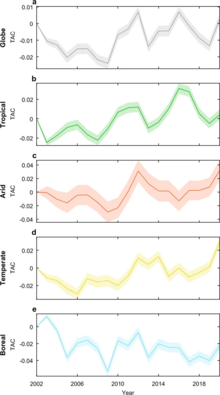Regime shift
[5][6][7][8] Although such non-linear changes have been widely studied in different disciplines ranging from atoms to climate dynamics,[9] regime shifts have gained importance in ecology because they can substantially affect the flow of ecosystem services that societies rely upon,[4][10] such as provision of food, clean water or climate regulation.
In ecology the idea of systems with multiple regimes, domains of attraction called alternative stable states, only arose in the late '60s based upon the first reflections on the meaning of stability in ecosystems by Richard Lewontin[1] and Crawford "Buzz" Holling.
[16] These early efforts to understand regime shifts were criticized for the difficulty of demonstrating bi-stability, their reliance on simulation models, and lack of high quality long-term data.
[17] However, by the 1990s more substantial evidence of regime shifts was collected for kelp forest, coral reefs, drylands and shallow lakes.
One example is historical institutionalism in political science, sociology and economics, where concepts like path dependency and critical junctures are used to explain phenomena where the output of a system is determined by its history, or the initial conditions, and where its domains of attraction are reinforced by feedbacks.
[18] A non-exhaustive range of current definitions of regime shifts in recent scientific literature from ecology and allied fields is collected in Table 1.
In short, regime shifts describe dynamics characterized by the possibility that a small disturbance can produce big effects.
Thus, the regime shift concept offers a framework to explore the dynamics and causal explanations of non-linear change in nature and society.
Early work on regime shifts in ecology was developed in models for predation, grazing, fisheries and inset outbreak dynamics.
Since the 1980s, further development of models has been complemented by empirical evidence for regime shifts from ecosystems including kelp forest, coral reefs, drylands and lakes.
Encroachment has been documented to impact ecosystem services related with cattle ranching in wet savannas in Africa and South America.
[24][25][26] At the regional scale, rainforest areas in the Amazon and East Asia are thought to be at risk of shifting towards savanna regimes given the weakening of the moisture recycling feedback driven by deforestation.
[27][28][29][30][31][32] The shift from forest to savanna potentially affects the provision of food, fresh water, climate regulation and support for biodiversity.
Once the lake has shifted to a murky water regime, a new feedback of phosphorus recycling maintains the system in the eutrophic state even if nutrient inputs are significantly reduced.
Another example widely studied in aquatic and marine systems is trophic level decline in food webs.
In high nutrient concentrations the levels of dissolved oxygen decrease, making life impossible for the majority of aquatic organisms.
Kelp forests are characteristically dominated by brown macroalgae and host high levels of biodiversity, providing provisioning ecosystem services for both the cosmetic industry and fisheries.
Such services are substantially reduced when a kelp forest shifts towards urchin barren regimes driven mainly by discharge of nutrients from the coast and overfishing.
For example, poverty has been proposed as a driver of dry land degradation, but studies continuously find contradictory evidence.
Regime shifts in polar regions include the melting of the Greenland ice sheet and the possible collapse of the thermohaline circulation system.
[62][63] Both regime shifts have serious implications for marine biodiversity, water cycling, security of housing and infrastructure and climate regulation amongst other ecosystem services.
Using current well-known statistical methods such as average standard deviates, principal component analysis, or artificial neural networks[64][20] one can detect whether a regime shift has occurred.
This question is important because, even if they have shown smooth change in the past, their dynamics can potentially become abrupt or discontinuous in the future depending on its parameters' configuration.
Therefore, a deep understanding of causal relationships and the strength of feedbacks is required to capture possible regime shift dynamics.


